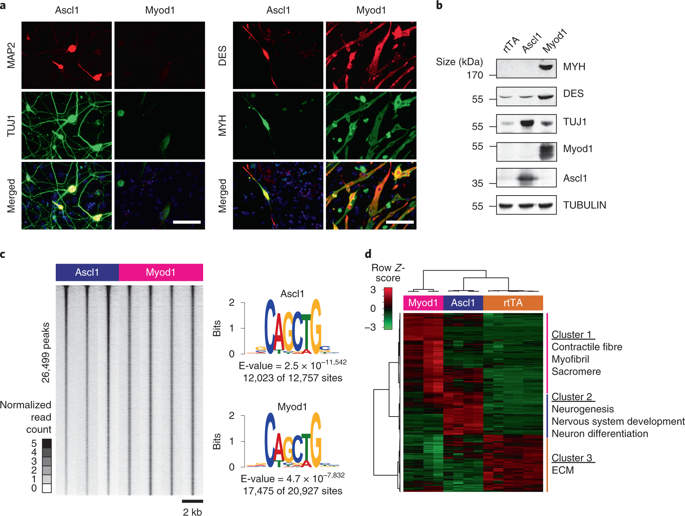当前位置:
X-MOL 学术
›
Nat. Cell Biol.
›
论文详情
Our official English website, www.x-mol.net, welcomes your
feedback! (Note: you will need to create a separate account there.)
Pro-neuronal activity of Myod1 due to promiscuous binding to neuronal genes.
Nature Cell Biology ( IF 17.3 ) Pub Date : 2020-03-30 , DOI: 10.1038/s41556-020-0490-3 Qian Yi Lee 1, 2, 3 , Moritz Mall 2, 4, 5, 6 , Soham Chanda 2, 7, 8 , Bo Zhou 2, 7 , Kylesh S Sharma 2 , Katie Schaukowitch 2 , Juan M Adrian-Segarra 4, 5, 6 , Sarah D Grieder 2, 4, 5, 6 , Michael S Kareta 2, 9 , Orly L Wapinski 10 , Cheen Euong Ang 1, 2 , Rui Li 10 , Thomas C Südhof 7 , Howard Y Chang 10 , Marius Wernig 2
Nature Cell Biology ( IF 17.3 ) Pub Date : 2020-03-30 , DOI: 10.1038/s41556-020-0490-3 Qian Yi Lee 1, 2, 3 , Moritz Mall 2, 4, 5, 6 , Soham Chanda 2, 7, 8 , Bo Zhou 2, 7 , Kylesh S Sharma 2 , Katie Schaukowitch 2 , Juan M Adrian-Segarra 4, 5, 6 , Sarah D Grieder 2, 4, 5, 6 , Michael S Kareta 2, 9 , Orly L Wapinski 10 , Cheen Euong Ang 1, 2 , Rui Li 10 , Thomas C Südhof 7 , Howard Y Chang 10 , Marius Wernig 2
Affiliation

|
The on-target pioneer factors Ascl1 and Myod1 are sequence-related but induce two developmentally unrelated lineages-that is, neuronal and muscle identities, respectively. It is unclear how these two basic helix-loop-helix (bHLH) factors mediate such fundamentally different outcomes. The chromatin binding of Ascl1 and Myod1 was surprisingly similar in fibroblasts, yet their transcriptional outputs were drastically different. We found that quantitative binding differences explained differential chromatin remodelling and gene activation. Although strong Ascl1 binding was exclusively associated with bHLH motifs, strong Myod1-binding sites were co-enriched with non-bHLH motifs, possibly explaining why Ascl1 is less context dependent. Finally, we observed that promiscuous binding of Myod1 to neuronal targets results in neuronal reprogramming when the muscle program is inhibited by Myt1l. Our findings suggest that chromatin access of on-target pioneer factors is primarily driven by the protein-DNA interaction, unlike ordinary context-dependent transcription factors, and that promiscuous transcription factor binding requires specific silencing mechanisms to ensure lineage fidelity.
中文翻译:

由于与神经元基因的混杂结合,Myod1 的前神经元活性。
靶向先驱因子 Ascl1 和 Myod1 与序列相关,但分别诱导两个发育不相关的谱系,即神经元和肌肉同一性。目前尚不清楚这两个基本螺旋-环-螺旋 (bHLH) 因素如何调节这些根本不同的结果。Ascl1 和 Myod1 的染色质结合在成纤维细胞中惊人地相似,但它们的转录输出却截然不同。我们发现定量结合差异解释了差异染色质重塑和基因激活。尽管强 Ascl1 结合仅与 bHLH 基序相关,但强 Myod1 结合位点与非 bHLH 基序共同富集,这可能解释了为什么 Ascl1 不依赖于上下文。最后,我们观察到当肌肉程序被 Myt1l 抑制时,Myod1 与神经元靶标的混杂结合会导致神经元重编程。我们的研究结果表明,与普通的上下文依赖性转录因子不同,靶向先驱因子的染色质访问主要由蛋白质-DNA 相互作用驱动,并且混杂的转录因子结合需要特定的沉默机制来确保谱系保真度。
更新日期:2020-04-24
中文翻译:

由于与神经元基因的混杂结合,Myod1 的前神经元活性。
靶向先驱因子 Ascl1 和 Myod1 与序列相关,但分别诱导两个发育不相关的谱系,即神经元和肌肉同一性。目前尚不清楚这两个基本螺旋-环-螺旋 (bHLH) 因素如何调节这些根本不同的结果。Ascl1 和 Myod1 的染色质结合在成纤维细胞中惊人地相似,但它们的转录输出却截然不同。我们发现定量结合差异解释了差异染色质重塑和基因激活。尽管强 Ascl1 结合仅与 bHLH 基序相关,但强 Myod1 结合位点与非 bHLH 基序共同富集,这可能解释了为什么 Ascl1 不依赖于上下文。最后,我们观察到当肌肉程序被 Myt1l 抑制时,Myod1 与神经元靶标的混杂结合会导致神经元重编程。我们的研究结果表明,与普通的上下文依赖性转录因子不同,靶向先驱因子的染色质访问主要由蛋白质-DNA 相互作用驱动,并且混杂的转录因子结合需要特定的沉默机制来确保谱系保真度。











































 京公网安备 11010802027423号
京公网安备 11010802027423号